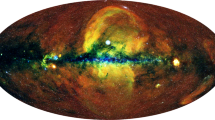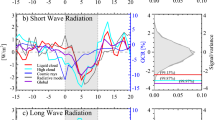Abstract
The abundances of heavy nuclei in the low energy primary cosmic ray flux can be accounted for by the co-existence of two components, one of which has undergone nuclear spallation reactions. The passage of primary cosmic rays through the ambient gas clouds thought to be associated with quasi-stellar objects is one way in which spallation on a sufficient scale may have occurred.
This is a preview of subscription content, access via your institution
Access options
Subscribe to this journal
Receive 51 print issues and online access
$199.00 per year
only $3.90 per issue
Buy this article
- Purchase on SpringerLink
- Instant access to full article PDF
Prices may be subject to local taxes which are calculated during checkout
Similar content being viewed by others
References
Webber, W. R., Handbuch der Physik, 46, (2), p. 248 (1967).
Comstock, G. M., Fan, C. Y., and Simpson, J. A., Astrophys. J., 146, 51 (1966).
Bernas, R., Gradsztajn, E., Reeves, H., and Schatzman, E., Annals of Physics (in the press, 1967).
Burbidge, G. R., Burbidge, M., Hoyle, F., and Lynds, C. R., Nature, 210, 774 (1966).
Sandage, A. R., and Luyten, W. J., Astrophys. J., 148, 767 (1967).
Hoyle, F., and Fowler, W. A., Nature, 213, 373 (1967).
Author information
Authors and Affiliations
Rights and permissions
About this article
Cite this article
BURBIDGE, G., FOWLER, W. & HOYLE, F. Origin of Low Energy Cosmic Rays from Outside the Solar System. Nature 216, 22–25 (1967). https://doi.org/10.1038/216022a0
Received:
Issue date:
DOI: https://doi.org/10.1038/216022a0
This article is cited by
-
The relative abundance of the carbon isotopes12C and13C in primary cosmic radiation
Astrophysics and Space Science (1970)
-
Cosmic ray nuclei of chargeZ⩾3 during the period of low solar activity
Proceedings of the Indian Academy of Sciences - Section A (1969)
-
Matter traversal of high-energy primary cosmic rays from antiproton measurements
Lettere al Nuovo Cimento (1969)



